History of the Outer Hebrides facts for kids
The Hebrides are islands off the coast of Scotland. People first settled here a very long time ago, around 8500–8250 BC. This was after the weather got warmer and better for living.
Some of the oldest buildings found are stone structures from about 3000 BC. The most famous are the amazing Callanish Standing Stones. These early people were likely Celts, just like others who settled in Scotland. Places like Northton in Harris show homes from the Beaker culture and Neolithic times. These are the oldest houses found in the Western Isles.
Contents
Ancient Times and Early Christianity
The first time the Outer Hebrides were written about was by a Greek historian named Diodorus Siculus in 55 BC. He wrote about an island called Hyperborea, meaning "Far to the North." On this island, there was a round temple where the moon seemed very close to the Earth every 19 years. This was probably a description of the Callanish stone circle.
Other ancient writers, like the Roman-Spanish writer Pomponius Mela, also mentioned these islands. This shows that people in the Hebrides had some contact with the Roman world.
Not much is known about the islands' history before the 500s AD. This time is sometimes called the "Dark Ages" because there are not many written records. The first clear records appear when St. Columba arrived in the 500s. This Irish-Scottish saint brought Christianity to the islands and started several churches.
The Viking Kingdom of the Isles
The Kingdom of the Isles was a Viking kingdom that ruled parts of the British Isles from 1079 to 1266.
This kingdom began when a Viking leader named Godred Crovan took over the Isle of Man in 1079. Before Godred, Vikings had already taken over the islands between 700 and 900 AD. The islands were ruled by Viking kingdoms from Dublin and Orkney. Godred's new kingdom was based on the Isle of Man. It also included the Outer Hebrides. The Inner Hebrides formed a separate part called the Kingdom of the Hebrides.
Hebrides Under Norse Rule
The Vikings called the Hebrides Suðreyar, meaning "southern islands." In 1098, Edgar of Scotland officially agreed that Magnus III of Norway was the King of the Isles. This happened after Magnus III had quickly conquered the Orkney Islands, the Hebrides, and the Isle of Man. He took control from the local Viking leaders.
Norway's control over the Hebrides led to many battles. In 1156, the islands were split. The Outer Hebrides stayed under the Kingdom of Mann and the Isles. But the Inner Hebrides broke away under Somerled. He was a leader with both Norse and Celtic family ties. Even though the Inner Hebrides were still officially under Norway, their leaders spoke Scottish Gaelic and followed Gaelic culture.
Somerled later took control of the Isle of Man itself. He was the last king to rule over all the islands that had once been part of the Kingdom of the Isles. After Somerled died in 1164, the rulers of Mann no longer controlled the Inner Hebrides.
Hebrides Become Part of Scotland
In 1262, Scottish forces attacked Skye. This made Haakon IV, the King of Norway, sail to Scotland to deal with the problem. In late 1263, Haakon arrived with a huge invasion force of 200 ships and 15,000 men. Storms damaged the Norwegian fleet.
A small battle happened at Largs. The Norwegians and their allies from Man, led by Magnus Olafsson, didn't win a big victory against the Scots. After the battle, bad weather forced the Norwegian fleet to sail back to the Orkney Islands. King Haakon planned to stay there for the winter and continue his fight next summer. But he became ill and died in December that year.
Haakon's son, Magnus the Lawmaker, became king. He thought peace with Scotland was more important than keeping the islands. So, in 1266, the Treaty of Perth was signed. This treaty gave the Hebrides and the Isle of Man to Scotland. Scotland paid 4,000 marks and agreed to pay 100 marks each year. The treaty also said that Norway would keep control of Shetland and Orkney. Scottish rule over the Isle of Man was finally confirmed after the Manx people were defeated in the 1275 Battle of Ronaldsway.
History of Specific Islands
Barra
The Clan MacNeil has strong ties to the Isle of Barra. Their family history goes back to the O'Neill dynasty in Ireland, who came to Barra around the year 1000. Kisimul Castle is the old home of the MacNeils. It sits on an island in the bay, which is why the nearby village is called Castlebay.
Other interesting places on Barra include a blackhouse museum and old Iron Age forts called brochs.
Flannan Isles
The Flannan Isles are also known as 'The Seven Hunters'. One island, Eilean Taighe, has a ruined stone shelter. Eilean Mòr has a lighthouse and a ruined chapel dedicated to St Flannan. Lighthouse keepers called it the 'dog kennel' because it was so small.
It's not clear which St. Flannan the chapel honors. It could be a 7th-century abbot or a half-brother of an 8th-century saint. People used to make special trips to Eilean Mòr. They had unusual customs, like taking off their hats and turning clockwise when they reached the top. It's thought that the saint or his followers might have lived on these islands. However, people probably didn't live there all the time after the 800s, until the lighthouse was built.
Great Bernera
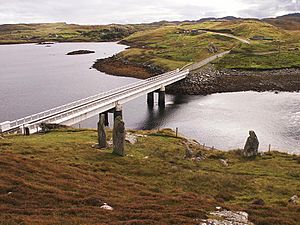
The main village on Great Bernera is Breaclete. It has a small museum. Bernera is also known for an Iron Age settlement at Bostadh. It was found in 1992 and is now covered by sand to protect it. A copy of an Iron Age house is built nearby. The island was also where the Bernera Riot happened, when farmers resisted being forced off their land.
Lewis
Historical Sites on Lewis
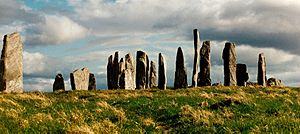
The Isle of Lewis has many interesting historical and archaeological places:
- The Callanish Stones, a famous stone circle.
- Dun Carloway Broch, an ancient round tower.
- Iron Age houses near Bostadh on Great Bernera.
- The Black House village at Garenin and the Black House at Arnol. These are traditional old homes.
- St. Columba's church in Aignish.
- Teampull Mholuaidh in Ness.
- Clach an Truiseil, a tall standing stone.
- Bonnie Prince Charlie's Monument at Arnish.
- Lews Castle.
- Butt of Lewis cliffs and Butt of Lewis Lighthouse.
- Dùn Èistean.
There are also many smaller stone circles and remains of brochs.
Key Events in Lewis's History
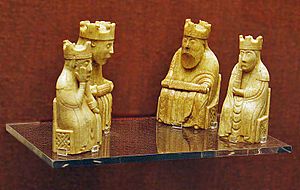
- Early Settlement: The first signs of people living on the islands are from about 8,000 years ago. Forests were burned to create grasslands for deer.
- First Farms: About 5,000 years ago, people started living in permanent farms. Their small houses have been found across the Western Isles. Large monuments like the temples and burial cairns at Calanais also date from this time.
- Iron Age: Around 500 BC, island society entered the Iron Age. Buildings became larger, like the brochs. These were round stone towers belonging to local chiefs. Dun Charlabhagh is a great example in Lewis.
- Christianity Arrives: In the 600s and 700s AD, Christianity began to spread.
- Viking Age: In the 800s AD, the Vikings arrived. They married local people and stopped their old beliefs. Buildings changed from round to rectangular, like Scandinavian styles. Lewis was part of the Kingdom of Mann and the Isles and officially part of Norway. The famous Lewis chessmen, found in 1831, are from this Viking period. The people were called Gall-Ghaidheil, meaning 'Foreigner Gaels', showing their mixed background.
- Battle of Largs (1263): This battle, though not in Lewis, led to Scotland defeating the Vikings. Lewis and the other islands were given to Scotland in 1266.
- Lordship of the Isles: In the 1300s, the Lordship of the Isles became very powerful in northwest Scotland. They were based on Islay but controlled all the Hebrides. They were descendants of Somerled, a Gall-Gaidheil lord.
- 18th Century Changes: After the 1745 rebellion, the use of Gaelic was discouraged. Rent had to be paid in money, not goods. Wearing traditional clothing was made illegal. Many people moved to the New World.
- 19th Century Clearances: Landlords forced many people off their lands. This led to more people leaving the islands. Lewis saw many 'land struggles' where people fought for their rights.
- World War I (1914–1918): Thousands of islanders served in the war, and many lost their lives.
- Iolaire Disaster (1919): On New Year's Day, the ship Iolaire sank near Stornoway harbor. Over 200 naval reservists from the island, returning home from the war, died.
- World War II (1939–1945): Again, Lewis contributed many people to the war, especially in the Royal Navy and Merchant Navy. Many lives were lost. After the war, more people moved to the Americas and mainland Scotland.
- Stornoway's Development: The town of Stornoway grew around a castle built in the Middle Ages. The castle was later destroyed. Ownership of Lewis changed hands many times.
- Stornoway Trust: Eventually, Lord Leverhulme gave the town's land to the Stornoway Trust, which still owns it today.
North Uist
North Uist has many very old structures. These include the Barpa Langass burial mound, the Pobull Fhinn stone circle, and the Fir Bhreige standing stones.
Scalpay
Eilean Glas, a small area on Scalpay's east coast, is home to the first lighthouse built in the Outer Hebrides.
South Uist
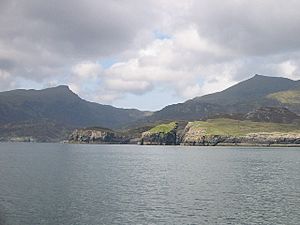
South Uist has the Kildonan Museum. It holds the 16th-century Clanranald Stone and the ruins of the house where Flora MacDonald was born.
Archaeological digs on South Uist have shown how homes changed from the Bronze Age to the 1800s. Iron Age roundhouses were different from 19th-century blackhouses. In blackhouses, people shared their living space with animals. This was a common Hebridean tradition, possibly influenced by the Vikings.
An excavation at Bornais on South Uist found what is likely the largest Viking settlement in Scotland. The archaeological site of Cladh Hallan on South Uist is the only place in the British Isles where prehistoric mummies have been found.
St Kilda
St Kilda was lived in for over 2,000 years, from the Bronze Age until the 1900s. Not much is known about its early history. The first written record is from the late 1300s. The islands were part of the lands of the Clan MacLeod of Harris.
In the 1700s, visiting ships brought diseases like cholera and smallpox. In 1727, so many people died that new families had to be brought in from Harris. By 1758, the population was 88, and it reached almost 100 by the end of the century. This number stayed steady until 1851, when 36 islanders moved to Australia. The island never fully recovered from this loss.
Tourism also changed St Kilda. In the 1800s, steamships started visiting. Islanders could earn money selling tweed cloth and bird eggs. But tourists often saw them as strange, which hurt the islanders' self-respect.
By the early 1900s, formal schooling began. In 1906, the church was made bigger to include a schoolhouse. All children learned English as well as their native Gaelic. Better healthcare also helped reduce childhood illnesses. The population was stable at 75 to 80 people. No one knew that within a few years, people would leave the island for good.
St Kilda During World War One
Early in World War I, the Royal Navy set up a signal station on Hirta, the main island. This meant daily communication with the mainland for the first time. In response, a German submarine arrived on May 15, 1918. After a warning, it started shelling the island. The wireless station, church, and other buildings were damaged.
After this attack, a gun was placed on a hill overlooking the bay. But it was never fired in a real battle. More importantly for the islanders, the war brought regular contact with the outside world. It also slowly introduced a money-based economy. These changes made life easier but also made the islanders less self-reliant. These were reasons why the island was later evacuated.
The Evacuation of St Kilda
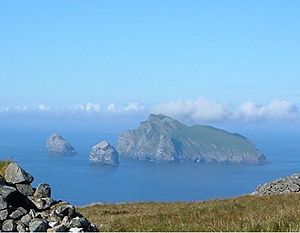
Tourism and the military presence during World War One showed the islanders that there were other ways to live. Life on St Kilda was very hard, and the islands were often cut off by bad weather. Even though a small jetty was built in 1902, the authorities couldn't do much to help them.
After World War One, most young men left the island. The population dropped from 73 in 1920 to 37 in 1928. After four men died from influenza in 1926, and several years of bad harvests, the final blow came in January 1930. A young woman, Mary Gillies, died from appendicitis. On August 29, 1930, the last 36 people living on St Kilda were moved to Morvern on the Scottish mainland. They had asked to leave.
St Kilda's Military Use Today
In 1955, the British government decided to use St Kilda as part of a missile tracking range. This range is based in Benbecula. So, in 1957, St Kilda became permanently inhabited again by military staff. New military buildings and masts have been built, including the island's first pub, the 'Puff Inn'. The Ministry of Defence rents St Kilda from the National Trust for Scotland. A small number of civilians still live on Hirta all year round, working at the military base.





